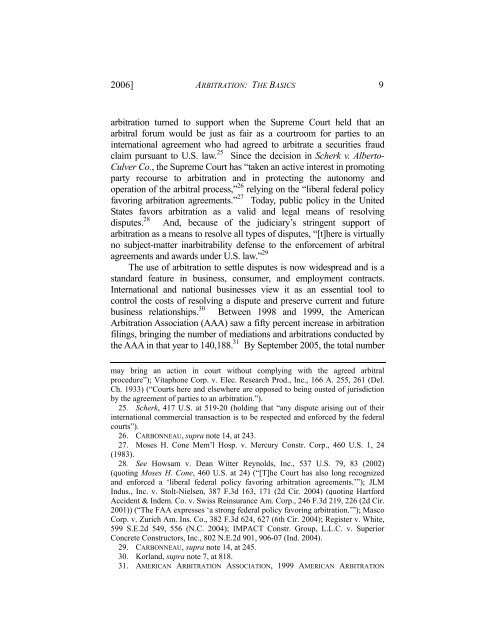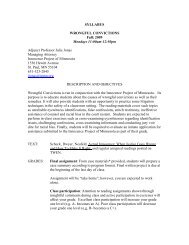2006/Vol. 5 No.1 - Hamline Law - Hamline University
2006/Vol. 5 No.1 - Hamline Law - Hamline University
2006/Vol. 5 No.1 - Hamline Law - Hamline University
Create successful ePaper yourself
Turn your PDF publications into a flip-book with our unique Google optimized e-Paper software.
<strong>2006</strong>] ARBITRATION: THE BASICS 9<br />
arbitration turned to support when the Supreme Court held that an<br />
arbitral forum would be just as fair as a courtroom for parties to an<br />
international agreement who had agreed to arbitrate a securities fraud<br />
claim pursuant to U.S. law. 25 Since the decision in Scherk v. Alberto-<br />
Culver Co., the Supreme Court has “taken an active interest in promoting<br />
party recourse to arbitration and in protecting the autonomy and<br />
operation of the arbitral process,” 26 relying on the “liberal federal policy<br />
favoring arbitration agreements.” 27 Today, public policy in the United<br />
States favors arbitration as a valid and legal means of resolving<br />
disputes. 28 And, because of the judiciary’s stringent support of<br />
arbitration as a means to resolve all types of disputes, “[t]here is virtually<br />
no subject-matter inarbitrability defense to the enforcement of arbitral<br />
agreements and awards under U.S. law.” 29<br />
The use of arbitration to settle disputes is now widespread and is a<br />
standard feature in business, consumer, and employment contracts.<br />
International and national businesses view it as an essential tool to<br />
control the costs of resolving a dispute and preserve current and future<br />
business relationships. 30 Between 1998 and 1999, the American<br />
Arbitration Association (AAA) saw a fifty percent increase in arbitration<br />
filings, bringing the number of mediations and arbitrations conducted by<br />
the AAA in that year to 140,188. 31 By September 2005, the total number<br />
may bring an action in court without complying with the agreed arbitral<br />
procedure”); Vitaphone Corp. v. Elec. Research Prod., Inc., 166 A. 255, 261 (Del.<br />
Ch. 1933) (“Courts here and elsewhere are opposed to being ousted of jurisdiction<br />
by the agreement of parties to an arbitration.”).<br />
25. Scherk, 417 U.S. at 519-20 (holding that “any dispute arising out of their<br />
international commercial transaction is to be respected and enforced by the federal<br />
courts”).<br />
26. CARBONNEAU, supra note 14, at 243.<br />
27. Moses H. Cone Mem’l Hosp. v. Mercury Constr. Corp., 460 U.S. 1, 24<br />
(1983).<br />
28. See Howsam v. Dean Witter Reynolds, Inc., 537 U.S. 79, 83 (2002)<br />
(quoting Moses H. Cone, 460 U.S. at 24) (“[T]he Court has also long recognized<br />
and enforced a ‘liberal federal policy favoring arbitration agreements.’”); JLM<br />
Indus., Inc. v. Stolt-Nielsen, 387 F.3d 163, 171 (2d Cir. 2004) (quoting Hartford<br />
Accident & Indem. Co. v. Swiss Reinsurance Am. Corp., 246 F.3d 219, 226 (2d Cir.<br />
2001)) (“The FAA expresses ‘a strong federal policy favoring arbitration.’”); Masco<br />
Corp. v. Zurich Am. Ins. Co., 382 F.3d 624, 627 (6th Cir. 2004); Register v. White,<br />
599 S.E.2d 549, 556 (N.C. 2004); IMPACT Constr. Group, L.L.C. v. Superior<br />
Concrete Constructors, Inc., 802 N.E.2d 901, 906-07 (Ind. 2004).<br />
29. CARBONNEAU, supra note 14, at 245.<br />
30. Korland, supra note 7, at 818.<br />
31. AMERICAN ARBITRATION ASSOCIATION, 1999 AMERICAN ARBITRATION
















